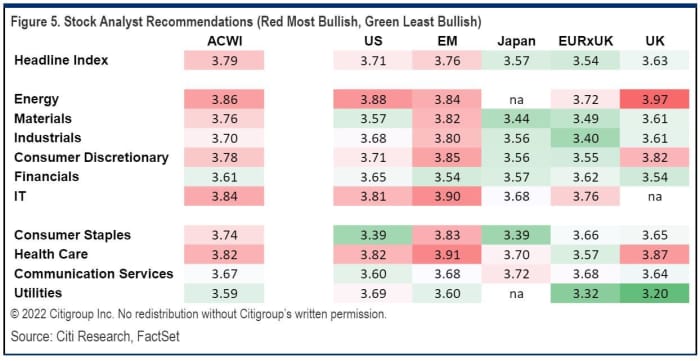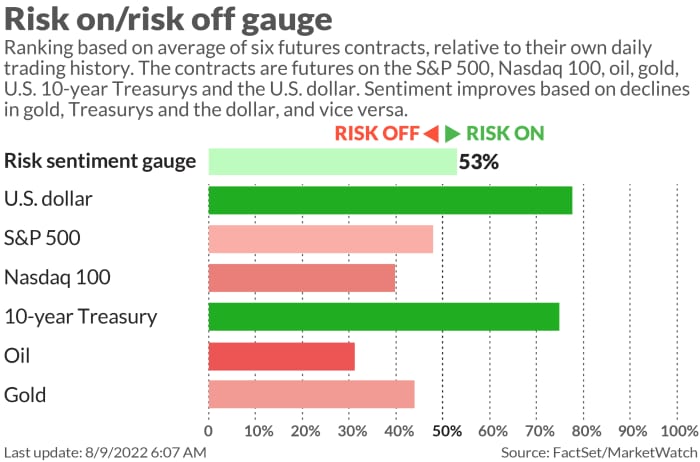The red flag that preceded a halving of global equities in 2000 and 2007 is back, warns Citi
We are a day away from data that could prove a turning point for markets.
If Wednesday’s CPI doesn’t reveal some slowing in prices, expectations will rise for a bigger Fed rate hike in September, possibly knocking stocks. But if it swings the other way, especially after surprisingly good jobs data, the view that things aren’t as bad as feared/Fed hikes may be done soon, could prevail.
Wall Street does seem to be at pains lately to advise treading carefully with optimism that has the S&P 500 SPX,
“The central challenge to the notion that there will be a more meaningful Fed pivot is that the near-term inflation picture is likely to remain uncomfortably high,” said Goldman Sachs strategists Dominic Wilson and Vicki Chang in a late Monday note.
But amid the caution, there’s still plenty of stock buying recommendations out there from the sell side, that is the brokerages and investment banks. And that’s a fat red flag investors may want to heed, warns our call of the day from Citigroup.
“Our index of global sell-side recommendations is back to peak bullishness levels reached in 2000 and 2007, after which global equities halved,” noted a team led by chief global equity strategist, Robert Buckland.
“Analysts are net buyers of every sector in every region, but then they usually are,” he said, noting specific concentration on U.S. and emerging markets. “They are still bullish on cyclical sectors suggesting few fears of oncoming global recession.”
Citi calculates its index of global sell-side calls by aggregating those on all stocks in MSCI indexes, ranging from 5, a strong buy, to 1, a strong sell. Their index is above three almost everywhere. They note that analysts are never net sellers of their stocks, even in the case of bear markets. While it seems analysts get more bullish as equities rise, it could also be that the “market rises because they are getting more bullish.”

In any case, that “analyst herding” has triggered a red flag in Citi’s bear market checklist, which has eased to 6 from a potential 18 flags. Note, this particular flag gave a false sell signal in 2012, when global stocks were flat for the following 12 months. But still, what happened in 2000 and 2007 makes it worth noting they say.
Buckland and the team say analysts tend to get the start of bear markets wrong, by turning even more bullish when they should be growing cautious. “Even though they are starting to revise down earnings forecasts, falling share prices and cheapening valuations keep them positive. They eventually do turn more cautious as earnings forecasts fall further, but it is a slow process.”
The markets

U.S. stocks DJIA,
The buzz
Take-Two TTWO,
Novavax shares NVAX,
Memory-chip group Micron Technology MU,
ARK Invest’s Cathie Wood told Bloomberg she sold some Coinbase stock COIN,
JPMorgan strategist and stoic bull Marko Kolanovic has suggested investors trim some stockholdings and scoop up commodities due to easing recession fears.
The FBI raided President Donald Trump’s Mar-a-Lago home, apparently looking for classified records. Some Republican lawmakers are outraged.
U.S. labor costs rose 10.8% in the second quarter, while productivity fell 4.6%.
Best of the web
It’s tough to find electric cars that qualify for the new EV tax credit.
All the reasons your restaurant tab is soaring.
Climate change is making lots of diseases worse.
Top tickers
These were the most active stock-market tickers on MarketWatch as of 6 a.m. Eastern:
| Ticker | Security name |
| GME, |
GameStop |
| AMC, |
AMC Entertainment |
| BBBY, |
Bed Bath & Beyond |
| TSLA, |
Tesla |
| NVAX, |
Novavax |
| NVDA, |
Nvidia |
| AAPL, |
Apple |
| NIO, |
NIO |
| TWTR, |
|
| AMZN, |
Amazon |
Random reads
Sleepy, dreaming spiders.
Rainbow-blowing gray whales.
The endless allure of these crime-fighting turtles.
Need to Know starts early and is updated until the opening bell, but sign up here to get it delivered once to your email box. The emailed version will be sent out at about 7:30 a.m. Eastern.




